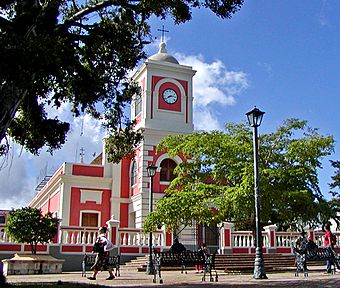Catedral Santiago Apóstol (Fajardo, Puerto Rico) facts for kids
Quick facts for kids |
|
|
Church Santiago Apóstol of Fajardo
|
|
 |
|
| Location | Town Plaza Fajardo, Puerto Rico |
|---|---|
| Architect | Don Pedro A. Beibal |
| MPS | Historic Churches of Puerto Rico TR |
| NRHP reference No. | 84003144 |
| Added to NRHP | September 18, 1984 |
The Cathedral of St. James the Apostle (also known as Catedral Santiago Apóstol or Santiago Apóstol of Fajardo) is a beautiful Catholic church in Fajardo, Puerto Rico. It stands proudly on the town plaza. This church is very important because it is one of the main churches for the Diocese of Fajardo-Humacao. The other main church is the Concatedral Dulce Nombre de Jesus in Humacao. In 1984, the church was added to the National Register of Historic Places, which means it's a special building worth protecting.
History of the Cathedral
The church's story began a long time ago. A parish, which is like a local church community, was started in 1766. The very first church building was finished in 1776.
Sadly, an earthquake in 1867 destroyed that first church. But people didn't give up! Just two years later, in 1869, they started building the church you see today. They even used some of the old side walls and floor tiles from the first building.
This church became a cathedral on March 11, 2008. This happened when Pope Benedict XVI created the Diocese of Fajardo-Humacao. A cathedral is the main church of a diocese, where the bishop has his special chair.
About the Architecture
The church was designed by an architect named Don Pedro A. Beibal. It is located on the north side of the town plaza. A concrete wall with pillars and metal gates surrounds the church.
The front of the church, called the main façade, has a tall, square bell tower. The bells are on the third level of the tower, inside open arches. On either side of the tower, there are two small windows. These windows show where the side aisles are inside the church. The sides of the church have a doorway and four windows each. A large house, built later, is behind the cathedral, so you can't see the back of the church easily.
Inside the church, simple pillars separate the main area (called the nave) from the side aisles. There are five pillars that divide the space into six sections. The first section is the entrance area, called the vestibule. Here, you'll find a spiral wooden staircase that leads up to the choir loft, where the choir sings. The area at the very end of the church, called the apse, is square. It has a brick dome with windows at the top, which lets light in.
See also
 In Spanish: Catedral de Santiago Apóstol (Fajardo) para niños
In Spanish: Catedral de Santiago Apóstol (Fajardo) para niños


